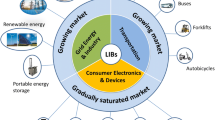Abstract
The proton exchange membrane electrolyzer (PEMWE) technology is an up-and-coming technology for the hydrogen vector. Although already present in the industry, it still presents several technological drawbacks. One of them concerns MEA, whose price is still high (mainly due to the noble metals used for the catalysts (iridium for example)), for a rather limited lifetime. Indeed, the MEAs degradation’s due to the PEMWE operation’s over a long time is an exciting study criterion, aiming to optimize their lifetime. During a PEMWE operating cycles, the aging mechanism is linked to the different combinations of parameters imposed on it, particularly the current and the set voltage. At the end of MEA life operation, the analysis of the voltage signals behaviour of a PEMWE with time revealed, during changes of operating points, a phenomenon of instability, which increases with the working time. Using mathematical descriptors to quantify these instabilities permit the prediction of the temporal evolution of this phenomenon.













Similar content being viewed by others
REFERENCES
Goodenough, J.B., Energy storage materials: a perspective, Energy Storage Mater., 2015, vol. 1, p. 158.
Koponen, J., Kosonen, A., Ruuskanen, V., Huoman, K., Niemelä, M., and Ahola, J., Control and energy efficiency of PEM water electrolyzers in renewable energy systems, Int. J. Hydrogen Energy, 2017, vol. 42, p. 29648.
Grigoriev, S.A., Fateev, V.N., Bessarabov, D.G., and Millet, P., Current status, research trends, and challenges in water electrolysis science and technology, Int. J. Hydrogen Energy, 2020, vol. 45, p. 26036.
Weiß, A., Siebel, A., Bernt, M., Shen, T.-H., Tileli, V., and Gasteiger, H.A., Impact of intermittent operation on lifetime and performance of a PEM water electrolyzer, J. Electrochem. Soc., 2019, vol. 166, p. F487.
Frensch, S.H., Fouda-Onana, F., Serre, G., Thoby, D., Araya, S.S., and Kær, S.K., Influence of the operation mode on PEM water electrolysis degradation, Int. J. Hydrogen Energy, 2019, vol. 44, p. 29889.
Grigoriev, S.A., Dzhus, K.A., Bessarabov, D.G., and Millet, P., Failure of PEM water electrolysis cells: case study involving anode dissolution and membrane thinning, Int. J. Hydrogen Energy, 2014, vol. 39, p. 20440.
Silva, R.A., Hashimoto, T., Thompson, G.E., and Rangel, C.M., Characterization of MEA degradation for an open air cathode PEM fuel cell, Int. J. Hydrogen Energy, 2012, vol. 37, p. 7299.
Siracusano, S., Van Dijk, N., Backhouse, R., Merlo, L., Baglio, V., and Aricò, A.S., Degradation issues of PEM electrolysis MEAs, Renew. Energy, 2018, vol. 123, p. 52.
Grigoriev, S.A., Bessarabov, D.G., and Fateev, V.N., Degradation mechanisms of MEA characteristics during water electrolysis in solid polymer electrolyte cells, Russ. J. Electrochem., 2017, vol. 53, p. 318.
Grigoriev, S.A., Bessarabov, D.G., and Glukhov, A.S., On the contamination of membrane-electrode assembles of water electrolyzers with solid polymer electrolyte by the elements of titanium alloys, Russ. J. Electrochem., 2017, vol. 58, p. 808.
Pivac, I., Šimić, B., and Barbir, F., Experimental diagnostics and modeling of inductive phenomena at low frequencies in impedance spectra of proton exchange membrane fuel cells, J. Power Sources, 2017, vol. 365, p. 240.
Barsoukov, E. and Macdonald, J.R., Impedance Spectroscopy, Hoboken: John Wiley & Sons, 2005.
Astafiev, E.A. and Ukshe, A., Flicker noise spectroscopy in the analysis of electrochemical noise of hydrogen-air PEM fuel cell during its degradation, Int. J. Electrochem. Sci., 2017, vol. 12, p. 1742.
Martemianov, S., Thomas, A., Adiutantov, N., Denisov, E., Evdokimov, Yu., and Hissel, D., Electrochemical noise analysis of a PEM fuel cell stack under long-time operation: noise signature in the frequency domain, J. Solid State Electrochem., 2020, vol. 24, p. 3059.
Li, N., Araya, S.S., Cui, X., and Kær, S.K., The effects of cationic impurities on the performance of proton exchange membrane water electrolyzer, J. Power Sources, 2020, vol. 473, p. 228617.
Parra-Restrepo, J., Bligny, R., Dillet, J., Didierjean, S., Stemmelen, D., Moyne, C., Degiovanni, A., and Maranzana, G., Influence of the porous transport layer properties on the mass and charge transfer in a segmented PEM electrolyzer, Int. J. Hydrogen Energy, 2020, vol. 45, p. 8094.
Sun, S., Shao, Z., Yu, H., Li, G., and Yi, B., Investigations on degradation of the long-term proton exchange membrane water electrolysis stack, J. Power Sources, 2014, vol. 267, p. 515.
Siracusano, S., Baglio, V., Van Dijk, N., Merlo, L., and Aricò, A.S., Enhanced performance and durability of low catalyst loading PEM water electrolyser based on a short-side chain perfluorosulfonic ionomer, Appl. Energy, 2017, vol. 192, p. 477.
Rozain, C., Mayousse, E., Guillet, N., and Millet, P., Influence of iridium oxide loadings on the performance of PEM water electrolysis cells: part I—pure IrO2-based anodes, Appl. Catal. B: Environ., 2016, vol. 182, p. 153.
Lee, J.K., Lee, C.H., Fahy, K.F., Zhao, B., LaManna, J.M., Baltic, E., Jacobson, D.L., Hussey, D.S., and Bazylak, A., Critical current density as a performance indicator for gas-evolving electrochemical devices, Cell Rep. Phys. Sci., 2020, vol. 1, p. 100147.
Majasan, J.O., Cho, J.I.S., Dedigama, I., Tsaoulidis, D., Shearing, P., and Brett, D.J.L., Two-phase flow behaviour and performance of polymer electrolyte membrane electrolyzers: electrochemical and optical characterization, Int. J. Hydrogen Energy, 2018, vol. 43, p. 15659.
Feng, Q., Yuan X.Z., Liu, G., Wei, B., Zhang, Z., Li, Hui., and Wang, H., A review of proton exchange membrane water electrolysis on degradation mechanisms and mitigation strategies, J. Power Sources, 2017, vol. 366, p. 33.
Author information
Authors and Affiliations
Corresponding author
Ethics declarations
The authors declare that there is no conflict of interest.
Rights and permissions
About this article
Cite this article
Boulevard, S., Kadjo, J.J., Thomas, A. et al. Characterization of Aging Effects during PEM Electrolyzer Operation Using Voltage Instabilities Evolution. Russ J Electrochem 58, 258–270 (2022). https://doi.org/10.1134/S102319352204005X
Received:
Revised:
Accepted:
Published:
Issue Date:
DOI: https://doi.org/10.1134/S102319352204005X




